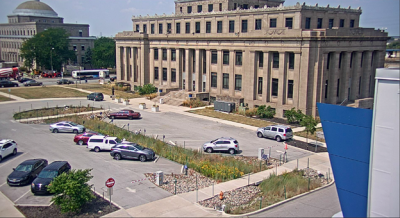GLRI projects can reduce sewer overflows to local waterways to improve the quality of water entering the Great Lakes. Cities can also benefit financially and environmentally by reducing discharges of stormwater runoff to the sewer system, eliminating the need for treatment. The U.S. Geological Survey (USGS) is measuring the effectiveness of green infrastructure in select cities across the Great Lakes basin. The green infrastructure project implemented at the city hall in Gary, Indiana, included removing impervious cover, repairing a failed subsurface drainage system, and redirecting stormwater from drains to a newly constructed rain garden.
Before construction of the rain garden in the parking lot of Gary City Hall in 2017, nearly all precipitation was conveyed away from the parking lot by underground drains, discharged to the sewer, and treated as sanitary waste at the Gary Sanitary District’s treatment plant or discharged directly to local waterways if stormflow exceeded capabilities of the sewage treatment plant.
In this GLRI-funded study, USGS evaluated pre- and post-construction hydrologic conditions using data collected by monitoring storm-sewer flow, groundwater levels, soil moisture, and meteorological conditions. Before construction of the rain garden, approximately 25 percent of rainfall discharged as stormwater to the sewer system. This rain garden now reduces stormwater runoff that otherwise would have flowed directly into Lake Michigan by over 80 percent. This study provides useful data for evaluating the benefits of future projects that would reduce impervious cover and replace it with green space and green infrastructure.


